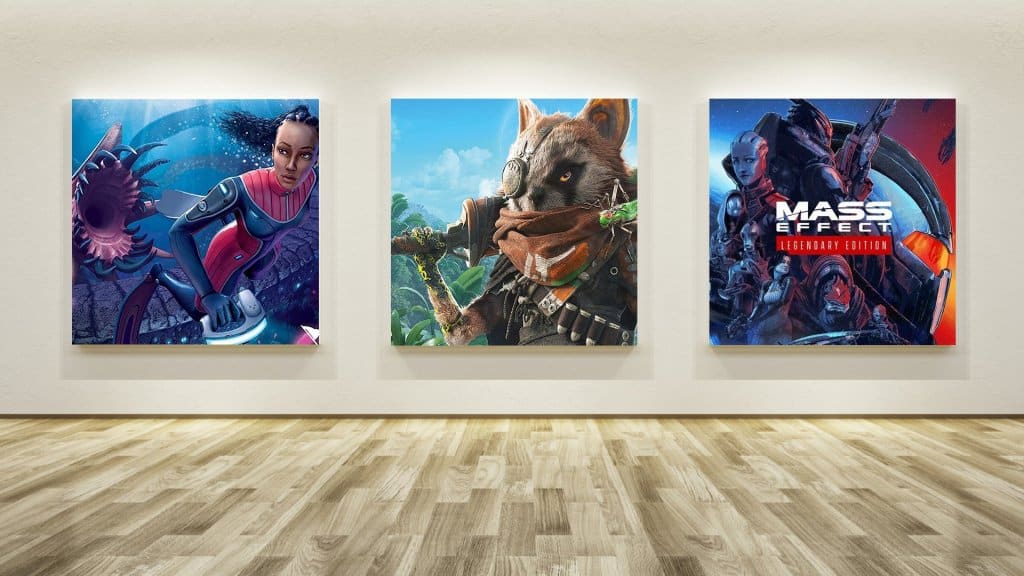Video Gamer is reader-supported. When you buy through links on our site, we may earn an affiliate commission. Prices subject to change. Learn more
Each month, we invite élite art critic Braithwaite Merriweather to appraise the box art of the latest game releases. In between his time spent wandering the corridors of culture, Merriweather writes on a freelance basis for various publications, including Snitters and Nuneaton à la Carte. If you are unaware of his prowess, rest assured; he’s on a crusade to educate the unwashed. Put simply, he’s a man that needs no introduction.
Friends! I have been cleaved in twain! You will be heartened to hear that I have had the first of two doses of vaccine; however, I am now a man divided. My left side feels as if the temperature has dropped below zero, set upon by shivers and a feelingless tingle. My right is seared by feverish heat. It goes without saying that I am marooned in solitude, and that I look now to that which has historically kept me in good spiritual health: the work! Arrayed before me is a sheaf of exciting new samples, sent to me by this venerable website, and, abiding by the advice given to me by Dr Jøhannes Wolfraüger—my sculpture tutor at the Hildebrand-Rothchild St. John-Benson-Brandruthson institute of fine, contemporary, and experimental art (may he rest in peace)—I am but clay, to be shaped, comforted, warmed, cooled, raised up, beaten down, softened, and hardened by the inspiration that surrounds me.
Biomutant

As far as I can tell, squinting through my private fog of pain and numbness (not altogether that different from any other week) this new work, entitled “Biomutant,” is notable for two reasons. One, it is not completely new; with its lens-glaring subject, its shoulder-slung sword, and its vista of steamed greens under a sky of forgetful blue, there is no ingredient here that we haven’t seen before. And two, in the mangling and splicing of these elements, and in the chirp of its details, newness is, against all odds, acquired, like an evolutionary trait emerging from a few million years of mess and stress.
I am reminded—as indeed I often am—of my ex-wife here. Note the scowl; the ears, pricked up for the susurration of money; the essential cattiness; the claw, gripped around a blade; and the mechanical, insectoid companion, perched on the shoulder and whispering to her, just like her solicitor. I am also reminded, perhaps more pertinently, of the work of Albrecht Dürer: specifically, of “The Wing of a Blue Roller” (1512) and “A Young Hare” (1502). “Biomutant” seems to me the result of a mashing together of these works; its subject, for one thing, possesses a harelike quality, and the hues (Dürer worked in watercolours and gouache) have seemingly broken the dam of Dürer’s canvas and crashed all about the frame of the new work. It suits it well, and the artist behind it pays homage to the precision of those works, while encouraging their merry malformation into something fresh, and bizarre. Bravo!
Subnautica: Below Zero

This chilly new piece, entitled “Subnautica: Below Zero,” is a tale of two halves, and a tale of two works—to say nothing of the fact that it is a work of two tails. One belongs to a creature as large, and by the looks of things as temperamental, as the iron brutes that churn past my windows, courtesy of Great Western Railway. The other is owned by what appears to be a shark with a face that seems to have been splayed by a shotgun shell—the mouth peeling apart in all directions, serried fangs bearing themselves for brunch. Then, of course, we have the subject: a woman, stitched into a wetsuit and clutching what looks like an iron, as if she were ready to press the creases from her lunging foe—to straighten him out, as it were.
The two works that writhe under the surface of “Subnautica: Below Zero,” in all their cold, crystalline depth, are “The Icebergs,” (1861) by Frederic Edwin Church, and “The Sea of Ice” (1823–1824), by Caspar David Friedrich. In both we see the bones of a shipwreck; Church gives us a cracked streak of brown, depicting a broken-off crow’s nest, while Friedrich lays down a blue-black chunk of hull off to the right—ruptured perhaps by the ice, which seems to have risen like an instant cathedral. I am delighted to report that the artist behind this new work is not merely paying limp-minded homage to the masters of the past, but is livening up those lonely wastes with pluck and adventure. If you have drifted off course, become marooned in solitude, and are feeling below zero, this piece seems to suggest, there is no cause to mope—adventure can be found anywhere, we all have hidden depths and crinkles, so zip up your wetsuit and grab your iron!
Mass Effect Legendary Edition

How odd that this month’s crop should consist of a heated and fruitful mutation, a frozen canvas split carefully down the middle, and now this: “Mass Effect Legendary Edition,” which is clumsily divided, blows hot and cold, and bears no fruit at all. We have a planet, composed of cooling blue and aggravated red, like an advert for heartburn medicine. Then there is a helmet, into which is reflected the fiery fall of a dozen ships. And finally a host of alien figures—some organic, with tentacles that have been Brylcreemed flat, and some robotic, with faces—and perhaps hearts—of stainless steel. What we don’t have is flair or talent. Consider “No 1 (Royal Red and Blue)” (1954), by Rothko, which looks as if someone had lugged a block of ice into Hell; to the thug, it may be a simple clash of colours, yet it refuses to melt from the memory. “Mass Effect Legendary Edition,” for all its clutter, has no complexity at all, and, despite its title, very little effect.

